-
Posts
4,105 -
Joined
-
Last visited
Content Type
Profiles
Forums
Events
Store
Posts posted by Robert Prudhomme
-
-
This diagram will help to explain how a bullet fragment could travel from the right rear of the skull to an exit wound on the throat.

-
Cliff
You have not shown one single piece of incontrovertible evidence to prove that JFK had a bullet wound (exit or entrance) in his throat prior to Z313.
Look at this:
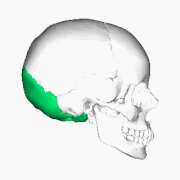
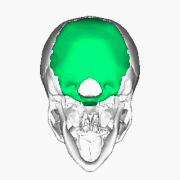


See the rather large opening in the inferior portion of the occipital bone, at the base of the skull? Do you not think it possible for a fragment of a bullet that entered the right rear of JFK's skull to pass through this opening and exit JFK's throat? Remember the description of the throat wound as being 3-5 mm? The Carcano bullet had a diameter of 6.77 mm.
-
Sooo, if my logical deductions tell me the throat wound was a wound of exit, and came from the breakup of the nose section of a very special bullet that entered the back of JFK's skull, just to the right of the external occipital protuberance, does that mean I am a disinfo agent?
-
Hi Cliff
You said this belonged in its own thread, so here it is.
If the bullet entered JFK's back at the level of thoracic vertebra T3, what became of the bullet?
Robert, there are only 3 conspiracy theories in the entire case that are worth a damn.
All 3 of those theories were rendered within 24 hours or so of JFK's murder.
This is one...
From autopsy-attendee FBI SA Francis O'Neill's 1978 sworn affidavit:
(quote on)
Some discussion did occur concerning the disintegration of the bullet. A general
feeling existed that a soft-nosed bullet struck JFK. There was discussion concerning
the back wound that the bullet could have been a "plastic" type or an "Ice" [sic]
bullet, one which dissolves after contact.
(quote off)
From autopsy-attendee FBI SA James Sibert's 1978 sworn affidavit:
(quote on)
The doctors also discussed a possible deflection of the bullet in the body caused
by striking bone. Consideration was also given to a type of bullet which fragments
completely....Following discussion among the doctors relating to the back injury, I
left the autopsy room to call the FBI Laboratory and spoke with Agent Chuch [sic]
Killion. I asked if he could furnish any information regarding a type of bullet that
would almost completely fragmentize (sic).
(quote off)
The other 2 in chronological order, plus Col. William Corson's conspiracy theory regarding the murder of the Ngo Bros.
in So Viet 3 weeks before JFK 's demise.
2. Military journalist Gary Underhill to a friend the night of 11/22/63.
From Larry Hancock's Someone Would Have Talked, pg 496:
(quote on)
When [Gary] Underhill arrived at his friends', Robert and Charlene Fitzsimmons, home in New York City, it was late
and he was excited and scared. The couple was preparing for a trip to Europe and Robert was already asleep. Underhill
spoke with Charlene (Charley) Fitzsimmons at length while she continued packing for the trip.
Underhill's concern was that he had become aware of a "clique" within the CIA--a clique dealing with weapons and
gun-running and making money. These individuals had Far Eastern connections, narcotics was mentioned, supposedly
the clique was manipulating political intrigues to serve their own ends. Underhill believed that these individuals
had been involved with JFK's murder; he felt that JFK had become aware of their dealings and was about to move against
them in some fashion. He also believed that members of the clique knew that Underhill was aware of their dealings and
that his own life could well be in jeopardy.
(quote off)
3. The deep political intuition of Vincent Salandria and Harold Feldman.
(quote on)
I explained that the day after the Kennedy assassination I met with my then brother-in-law, Harold Feldman.
We decided that if Oswald was the killer, and if the U.S. government were innocent of any complicity in the
assassination, Oswald would live through the weekend. But if he was killed, then we would know that the
assassination was a consequence of a high level U.S. government plot.
Harold Feldman and I also concluded that if Oswald was killed by a Jew, it would indicate a high level WASP plot.
We further decided that the killing of Oswald would signal that no government investigation could upturn the truth.
In that event we as private citizens would have to investigate the assassination to arrive at the historical truth.
(quote off)
"Notes on Lunch with Arlen Specter," by Vincent Salandria.
http://politicalassassinations.com/2012/11/1560/
4. William Corson's contemporaneous analysis of the overthrow and murder of the Ngo brothers in So Vietnam.
From Joseph Trento's Secret History of the CIA, pgs 334-5:
(quote on)
Who changed the coup into the murder of Diem, Nhu and a Catholic priest accompanying them? To this day, nothing
has been found in government archives tying the killings to either John or Robert Kennedy. So how did the tools
and talents developed by Bill Harvey for ZR/RIFLE and Operation MONGOOSE get exported to Vietnam? Kennedy
immediately ordered (William R.) Corson to find out what had happened and who was responsible. The answer he
came up with: “On instructions from Averell Harriman…. The orders that ended in the deaths of Diem and his
brother originated with Harriman and were carried out by Henry Cabot Lodge’s own military assistant.”
Having served as ambassador to Moscow and governor of New York, W. Averell Harriman was in the middle of a long
public career. In 1960, President-elect Kennedy appointed him ambassador-at-large, to operate “with the full
confidence of the president and an intimate knowledge of all aspects of United States policy.” By 1963,
according to Corson, Harriman was running “Vietnam without consulting the president or the attorney general.”
The president had begun to suspect that not everyone on his national security team was loyal. As Corson put it,
“Kenny O’Donnell (JFK’s appointments secretary) was convinced that McGeorge Bundy, the national security advisor,
was taking orders from Ambassador Averell Harriman and not the president. He was especially worried about
Michael Forrestal, a young man on the White House staff who handled liaison on Vietnam with Harriman.”
At the heart of the murders was the sudden and strange recall of Saigon Station Chief Jocko Richardson and his
replacement by a no-name team barely known to history. The key member was a Special Operations Army officer,
John Michael Dunn, who took his orders, not from the normal CIA hierarchy but from Harriman and Forrestal.
According to Corson, “John Michael Dunn was known to be in touch with the coup plotters,” although Dunn’s role
has never been made public. Corson believes that Richardson was removed so that Dunn, assigned to Ambassador Lodge
for “special operations,” could act without hindrance.
(quote off)
And what does this post have to do with anything?
-
Here's Bennett's official statement.
http://www.history-matters.com/archive/jfk/wc/wcvols/wh18/html/WH_Vol18_0387b.htm
He stated he was facing the crowd on the right, consistent with Willis 5, then he turned to the front in time to see JFK shot in the back, consistent with his blurry features in Altgens 6.
Between Z186 and Z255 the witness statements and the photos match.
Right. And this is your iron clad evidence that JFK had a bullet wound in his throat. Remind me not to hire you as a defense lawyer.
-
I envy you, Robert. If I could live my life over I would find an avenue that got me into railroad employment. There's just something about trains that appeals to me, starting with my first Lionel train set many moons ago. Many words in the English language (such as 'deadbeat' & 'mule skinner') are attributed to railroad terminology (lingo). The railroads helped build America & provided employment for minorities at a time when little else was available.
You are in an elite group that is familiar with the sounds of train activity & I'm sure you are well accustomed to loud noises that occur regularly around train stations as locomotives hook up to railcars as well as the sound of 'torpedoes'. Many people are not that familiar with the sounds of train activity other than the sound of its horns or how similar the tornado sounded to it (LOL). It's often glossed over or ignored that JFK was driven past such a train station & I believe it's important to the story to focus on the rail yards as an important part of the overall scenario.
I hope Robert Maddy does not find fault with my comments; I didn't present them in an argumentive spirit or try to 'derail' his theory of pergola shooters. I'm merely pointing out that the pergola & the stockade fence are both on the Southern & Western perimeters of the rail yards. When Sheriff decker ordered his men into the rail yards, had he gotten out of Jesse Curry's white Ford Galaxie lead car following traversing the TUP & gone up the bridge embankment he would have been in the rail yards he ordered his men to report to. Decker was that close it. What he heard that impressed him the sounds of 'gunfire' originated in that area is important to understanding what happened IMHO. Decker might have even noticed Dan Rather standing nearby waiting to make his film drop.
I hope Robert Maddy doesn't take issue with anything I stated; I presented what some people are thinking but too timid to post about (perhaps?).
As you,know, I am an admirer of your work in the area of small arms, ballistics & ammo, Mr. Prudhomme. Everyone stands to learn a great deal from you.
Sincerely,
BM
I sometimes wish I'd been born early enough to have worked on steam locomotives. There's just something beautiful about them and their whistles that I never found in diesel locomotives.
-
"Mrs. Connally:...I heard a noise, and not being an expert rifleman, I was not aware that it was
a rifle. It was just a frightening noise, and it came from the right. I turned over my right shoulder
and looked back, and saw the President as he had both hands at his neck.
Mr. Specter: And you are indicating with your own hands, two hands crossing over
gripping your own neck?"
But Cliff, we know, from examining the Z film, that Nellie was mistaken and JFK was not actually gripping his own neck, no matter how much Specter was attempting to lead this witness.
Quoting witnesses that were behind JFK is rather pointless, as they could see his arms up near his throat, but had no idea what he was doing.
Have you ever seen anyone in respiratory distress from a lung injury?
-
Hi Brad
Coincidentally, I worked as a railroad brakeman for a couple of years way back in the early 1970's, for both the Canadian Pacific Railroad and the British Columbia Railroad.Torpedoes are part of the brakeman's flagging kit, and are clipped onto the rails in two pairs 50 yards (or is it feet? Been a while) out a good distance from where the flagman has taken up his position to stop a train.
Yes, indeed, they are loud. I was in the locomotive of a northbound train just south of Williams Lake on the BCR. We were going through a 10 mph slow order, just crawling along in the summer heat on a hot locomotive (I was damn near falling asleep, to be honest LOL), when our lead wheels right under the cab rolled over a pair of torpedoes. The engineer had spotted them and was ready for them, but thought it would be amusing to watch his dozy brakeman go through the roof. Well, just like you said, I nearly jumped out of my skin when they went off, and the hogger had a good laugh at my expense.
-
You don't get it, Cliff. You can't say JFK was shot in the throat, simply because Bennett hears a shot. What kind of logic is that?
Can you name any other witnesses who heard back to back shots at z202?
-
"Robert faces the challenge of explaining how shooters with high powered weapons could be shooting at JFK within feet or yards of the Hestors, Zapruder & Sitzman without causing them to literally 'jump out of their shoes'."
I'm not sure which Robert you are referring to, Brad, but, yes, that is an excellent point you make.
-
So Nellie was describing JFK as "dealing with throat issues". Do you not think it possible that a man, shot in the lung and likely bleeding profusely into the pleural cavity, and unable to breathe with that lung, might show some form of respiratory distress that might be easily confused with "throat issues"? Seriously, is that the best you can do?
Yeah, I have another winess for you to bash.
SSSA Glenn Bennett's contemporaneous notes:
(quote on)
...The Presidents auto moved down a slight grade and the crowd was very sparse.
At this point I heard a noise that immediately reminded of a firecracker. Immediately
upon hearing the so called firecracker, looked at the Boss's car. At this exact time I
saw a shot that hit the Boss about 4 inches down from the right shoulder; a second
shot followed immediately and hit the right rear high of the Boss's head.
(quote off)
Bennett was looking to his right at Z202. The back shot followed the throat shot by several seconds.
Sorry, Robert.
You got nuttin.
Bennett hears a shot, and this is your evidence of a throat wound. Wow.
How do you know he's not combining the sound of the shot he heard with the hit he sees on the back? "At this exact time I saw a shot that hit the Boss about 4 inches down from the right shoulder..." Bennett may have been looking a little to his right, but JFK would still be in his field of vision.
I got nuttin? No, YOU got nuttin. You still have not shown one shred of proof that JFK had a throat wound before z313.
-
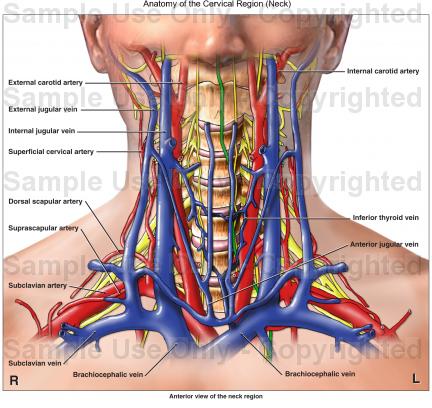
Why was there no blood visible in the area of JFK's throat? Or was he "different", and did not have any of these blood vessels in his neck?
You see his entire neck covered over with blood vessels?
Let me guess, you've got a Magic Bullet that will wind its way through those blood vessels. You're almost as much fun as David Von Pain.
Of course it hit blood vessels. Shows it right on the x-ray. Doesn't mean it hit the jugular.
Savvy "internal bleeding"?
Not that close to the surface.
-
So Nellie was describing JFK as "dealing with throat issues". Do you not think it possible that a man, shot in the lung and likely bleeding profusely into the pleural cavity, and unable to breathe with that lung, might show some form of respiratory distress that might be easily confused with "throat issues"? Seriously, is that the best you can do?
"Since the round was originally designed to silence guard dogs -- wounds caused by this type of weaponry were not readily visible."
Are you for real?
I'm not sure the point of this contentless non-rebuttal.
The weapon was used to silence guard dogs without leaving anyone suspicious.
What part of this don't you grasp?
JFK had a fricking hole in his neck that did not materialize until he got to Parkland??????
Why didn't *your* bone fragment hit the jugular and make a mess upon exit?
You've never hunted before, right?
You haven't done your homework, right?
http://www.aarclibrary.org/publib/church/reports/vol1/pdf/ChurchV1_6_Senseney.pdf
You're hilarious, Cliff. No wonder no one takes us seriously.
Why would a wound from your magic gun be any less visible than a wound from any other gun? This argument does absolutely nothing to prove the throat wound was there when you say it was.
And I did not say a bone fragment exited his throat, I stated a bullet fragment exited his throat. Also, with the amount of blood from the head wound all over everything, the blood from a jugular vein or carotid artery would not be noticeable. On top of this, JFK's heart likely stopped beating about the time the bullet(s) went through his brain, as evidenced by no spurting arterial bleeds seen in the Z film post z313.
-

Why was there no blood visible in the area of JFK's throat? Or was he "different", and did not have any of these blood vessels in his neck?
You see his entire neck covered over with blood vessels?
Let me guess, you've got a Magic Bullet that will wind its way through those blood vessels. You're almost as much fun as David Von Pain.
-
So Nellie was describing JFK as "dealing with throat issues". Do you not think it possible that a man, shot in the lung and likely bleeding profusely into the pleural cavity, and unable to breathe with that lung, might show some form of respiratory distress that might be easily confused with "throat issues"? Seriously, is that the best you can do?
"Since the round was originally designed to silence guard dogs -- wounds caused by this type of weaponry were not readily visible."
Are you for real? JFK had a fricking hole in his neck that did not materialize until he got to Parkland?????? You've never hunted before, right?
-

Why was there no blood visible in the area of JFK's throat? Or was he "different", and did not have any of these blood vessels in his neck?
-
Show me one single witness in Dealey Plaza that saw a hole in JFK's throat. You are so hung up on on these dissolving poison darts, you have blinded yourself to the possibility JFK was only shot in the back, prior to z313.
-
Now, again, please explain to me how your poison projectile did not sever JFK's right carotid artery, and why the Z film does not show great spouts of blood erupting from JFK's neck.
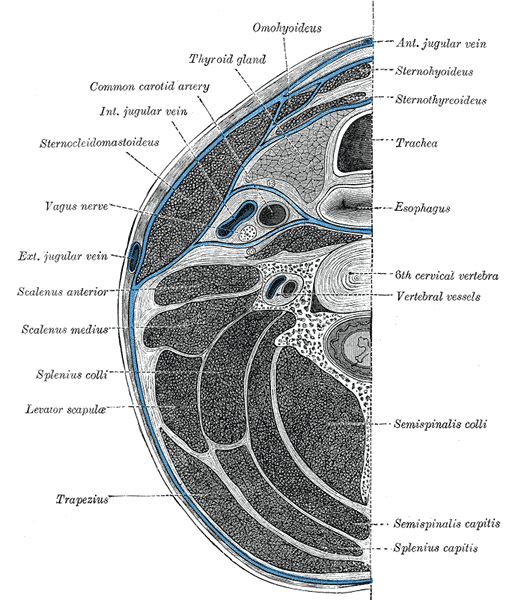
See the anterior jugular vein at the very top of the diagram, positioned just above the trachea? It would have been directly in line with your projectile, and severing it would have produced a LOT of blood.
-
I hate to rain on your parade but, this is not evidence of a bullet hole in JFK's throat. He could be reacting to a bullet in the top of his right lung, at this point.
-
Where did all of the metal fragments go? Did you not read the part about Jerrol Custer testifying to the ARRB that the neck x-ray he remembered seeing showed a great number of metal fragments?
Did you not read also that Jerrol Custer testified to the ARRB that the Y incision had already been made on JFK's torso and most of the organs removed PRIOR to his x-raying the torso?
Hint: The lungs are also considered organs.
-
The problem you have here, as I see it, is that you need this pistol like weapon to deliver a projectile into JFK's throat, but you don't dare have it go in more than an inch, or it will rip apart the carotid artery on the right side of the trachea. The SBT supporters have precisely the same problem, only in reverse.
A .45 Colt handgun fired at JFK's throat from that range would have made a very large mess, and likely would have broken some cervical vertebrae. So, your handgun had to have its velocity drastically reduced, in order to prevent its projectile from tearing apart the carotid artery and breaking vertebrae.
Its velocity would have to be so low, it would be ridiculously inaccurate. Maybe Umbrella Man could have made the shot.
Now, IF JFK's carotid artery had been severed, and I cannot see how even your projectile could have avoided doing that, if it went by the trachea with sufficient force and velocity to tear it, viewer's of the Z film would have seen great spouts of blood erupting from JFK's neck, and Nellie most certainly would NOT have said there was no blood visible.
-
You don't understand the first thing about a pneumothorax, right?
-
It did not merely "nick" the trachea, it tore the right side of the trachea, leaving a long hole in it. That is why the tracheostomy was necessary. They attempted to only intubate JFK at first but found, when positive pressure ventilation was initiated, that all of the air was escaping through the trachea.
The throat wound should have bled profusely.
If the throat wound was behind the tie knot, how were all of these witnesses able to see it, aside from the fact it was a tiny wound 3-5 mm in diameter? How do the photographs and the Z film establish the existence of this wound?
P.S.
Please show me the left forefinger "clutching" the necktie, and explain to me why you have to type it as "clutching".
-
Cliff
Think about something very hard here for a second. If the "projectile" that entered JFK's back caused a hairline fracture of the T1 transverse process as it passed over it, two inescapable facts are established:
1. The bullet had to travel further than the transverse process of T1.
2. In order to fracture this bone, the bullet had to be travelling at a sufficient velocity, in order to have this much energy, that would have propelled it straight through JFK's neck and out the front of his neck. If we rule out the throat wound as an exit site, where did it go?
Or, do you believe the projectile dissolved within JFK? I'd really like to see what kind of projectile is capable of this.


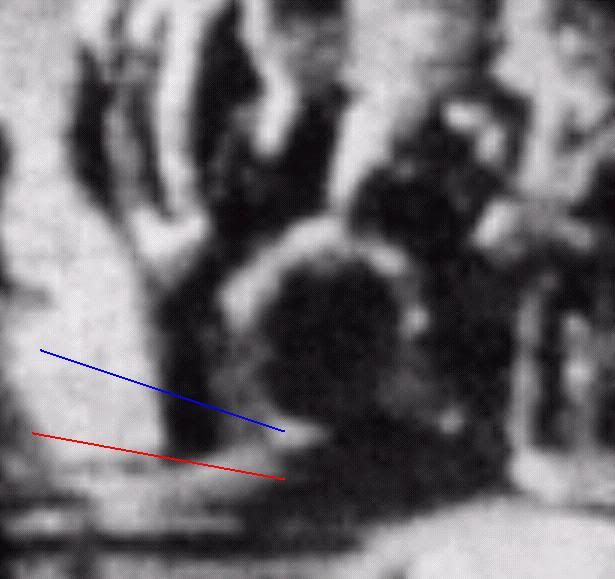

For Cliff Varnell: Where did the Bullet in JFK's Back go?
in JFK Assassination Debate
Posted
Once again, Cliff, have you ever seen a patient in traumatic respiratory distress from a lung injury?